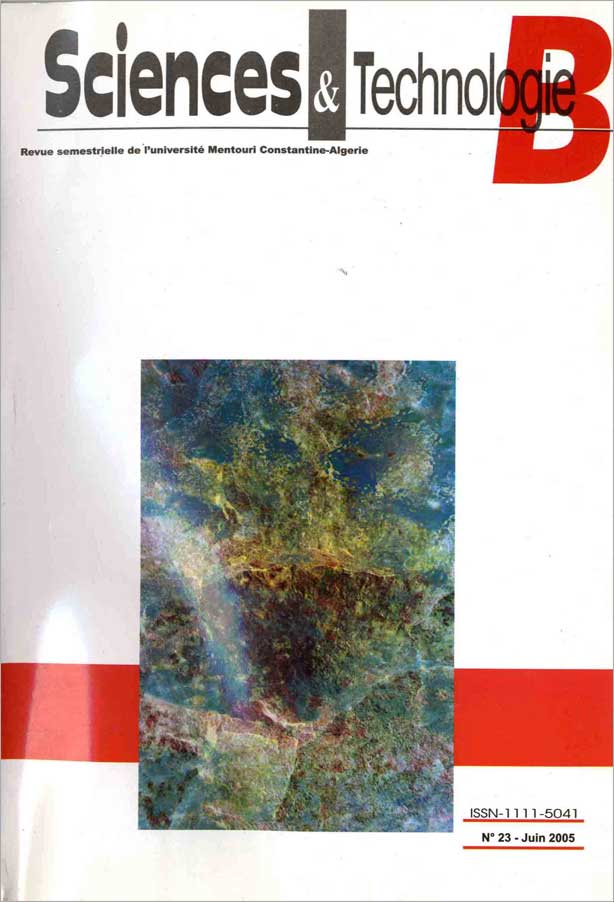EVALUATION OF HEAD LOSSES IN FLUID TRANSPORTATION NETWORKS
Mots-clés :
Frictional head losses, Minor head losses, Singular head losses, Water distribution networkRésumé
Energy losses in pipes used for the transportation of fluids (water, petroleum, gas,etc.) are essentially due to friction, as well as to the diverse singularities encountered. These losses are usually converted into head reductions in the direction of the flow. The knowledge of data of such transformation allows the determination of the necessary power needed for the transportation of the fluid between two points. It constitutes the necessary calculation basis necessaryfor the design and analysis of transport and distribution networks. The review of the different relationships allowing the determination of these losses and their comparison to the experimental results obtained by the authors, constitute the object of this
study.
Références
Lahiouel Y., Haddad A., Khezzar L., Chaoui K., Kondratas A., “Development of method of routing fluid distribution
networks”, J. Mechanica, Vol. 43, N° 4, (2003), pp. 27-34.
Weisbach J., “Die Experimental Hydraulik”, Freiberg,
Germany: Engelhardt, (1855).
Bhave, P.R., “Analysis of flow in water distribution networks”, pp.25-68 Technomic Pub. Co.,Inc., USA, (1991).
Nikuradse J., 1933, “Strِmungsgesetze in Rauben Rohren”, pp.
, Verein Deutsher Ingenieure, Forschungsheft, (1933).
Colebrook C.F., “Turbulent Flow in Pipes with Particular
reference to the Transition Region between the Smooth and
Rough Pipe Laws”, J. Inst. of Civil Engrs., N° 11, (1939), pp.
-156.
Johnson, S.P., “A Survey ofFlow Calculation Methods”,
Preprinted Paper for Summer Meeting, Am. Soc. of Mech.
Engrs, (1934).
Rouse H., “Evaluation of Boundary Roughness”, Proc. 2nd
Hydraul. Conf., Bulletin N° 27, Univ. of Lowa, Lowa City, (1943).
Moody L.F., “Friction Factors for Pipe Flow”, Trans.
American Society of Mechanical. Engineers., N° 66, (1944),
pp. 671-684.
Blasius H., “Das Ahnlichkeitsgesetz in Flussigkeiten”, pp. 131, Verein Deutscher Ingenieure, Forschungsheft, (1913).
Ger A.M. and Holly E.R., “Comparison of single point
injections in Pipe Flow”, J. Hydraul. Div., Am. Soc. of Civil
Engrs., Vol. HY6, N° 102, (1976), pp. 731-746.
Techo R., Tichner R.R. and James R.E., “An Accurate
Equation for the Computation of Friction Factor for Smooth
Pipes from the Reynolds Number”, J. of Applied Mechanics,
N° 32, (1965), pp. 443.
Chen J.J.J., “A Simple Explicit Formula for the Estimation of Pipe Friction Factor”, Proc. Inst. of Civil Engrs., Vol. 2, N°
, (1984), pp. 49-55.
Wood D.J., “An Explicit Friction Factor Relationship”, Civil
Engineering, Am. Soc. of Civil Engrs., Vol. 12, N° 36, (1972),
pp. 383-390.
Barr D.I.H., “New Forms of Equation for the correlation of
Resistance Data”, Proc. Inst. ofCivil Engrs., vol. 2, N°59,
(1975), pp. 827-835.
Jain A.K., Mohan, D.M. and Khanna P., “Modified HazenWilliams Formula”, J.Environ. Engrg. Div., Am. Soc. of Civil Engrs., Vol. EEI, N° 104, (1978), pp. 137-146.
Swamee P.K. and Jain A.K., “Explicit Equations for Pipe
Flow Problems”, J.Hydraul. Div., Am. Soc. of Civil Engrs.,
Vol. HY11, N° 102, (1976), pp. 1707-1709.
Zigrang D.J. and Sylvester N.D., “Explicit Approximations to the Solution of Colebrook’s Friction Factor Equation”, J. Am.
Inst. of Chemical Engrs., Vol. 3, N° 28, (1982), pp. 514-515.
Haaland S.E., “Simple and Explicit Formulas for the Friction Factor in Turbulent Pipe Flow”, J. Fluids Engrs., Vol. 89, N° 105, (1983), pp. 89-90.
Churchill S.W., “Friction Factor Equation Spans All Fluid
Flow Regimes”, Chemical Engineering, N° 84, (1977), pp.
-92.
Chen J.J.J., “Systematic Explicit Solutions of the Prandtl and Colebrook-White Equation for Pipe Flow”, Proc. Inst. of Civil Engrs., Vol. 2, N° 79, (1985), pp. 383-389.
Williams G.S. and Hazen A., “Hydraulic tables”, 3rd Edition, John Wiley & Sons inc., USA, (1933).
Lamont P., “The Choice of the Pipe Flow Laws for Practical Use”, Water and Water Engineering, Vol. 875, N° 73, (1969), pp. 55-63.
White W.R., “The Hydraulic Characteristics of Clayware
Pipes”, Hydraulic Research Station, Report No. Int. 133,
Wallingford, Berkshire, England, (1974).
Jain A.K., “Accurate Explicit Equation for Friction Factor”,
J. Hydraul. Div., Am. Soc. of Civil Engrs., Vol. HY5, N° 102,
(1976), pp. 674-677.
Morel M.A. and Laborde J.P., “Exercices de Mécanique des
Fluides”, pp. 79-86, Volume 1,Chihab-Eyrolles Editions,
Algeria, (1994).
Scobey F.C., “The flow of water in commercially smooth
pipes”, Water Ressources CenterArchives, Series report 17,
Univ. of California, Berkeley, USA, (1966).
Powell R.W., “The Origin of Manning Formula”, J. Hydraul.
Div., American Society of Civil Engrs., Vol. HY4, N° 94, (1968), pp. 1179-1181.
Williams G.P., “Manning Formula-A Misnomer?”, J. Hydraul. Div., American Society of Civil Engrs., Vol. HY1, N° 96, (1970), pp. 193-200.
Lahiouel Y., Haddad A. “Evaluation of energy losses in
pipes”, Proc. of the Saoudi Engineering, Dhahran, Saoudi
Arab, 2002, vol. 5, pp. 577-589
Haddad A. and Lahiouel Y., “Analyse des réseaux de
distribution d’eau par la méthode de Cross et l’approche
linéaire”, Trans. of the 4th Mech. Engg. Cong., vol. 2,
Mohammadia, Morocco, (1999), pp. 89-90.
Haddad A., Bouachari A. and Boudebza C., “Pertes de charge régulières et singulières le long du tronçon Oléoduc SP-3”, Internal report, Guelma Univ., Algeria, (1999).
Téléchargements
Publié-e
Comment citer
Numéro
Rubrique
Licence
Les auteurs publiant dans cette revue acceptent les termes suivants :- Les auteurs détiennent le droit d'auteurs et accordent à la revue
le droit de première publication, avec l’ouvrage disponible simultanément [SPÉCIFIER LA PÉRIODE DE TEMPS] après publication, sous la licence Licence d’attribution Creative Commons qui permet à d'autres de partager l'ouvrage en en reconnaissant la paternité et la publication initiale dans cette revue. - Les auteurs peuvent conclure des ententes contractuelles additionnelles et séparées pour la diffusion non exclusive de la version imprimée de l'ouvrage par la revue (par ex., le dépôt institutionnel ou la publication dans un livre), accompagné d'une mention reconnaissant sa publication initiale dans cette revue.
- Les auteurs ont le droit et sont encouragés à publier leur ouvrage en ligne (par ex., dans un dépôt institutionnel ou sur le site Web d'une institution) avant et pendant le processus de soumission, car cela peut mener à des échanges fructueux ainsi qu'à un nombre plus important, plus rapidement, de références à l’ouvrage publié (Consulter The Effect of Open Access).

